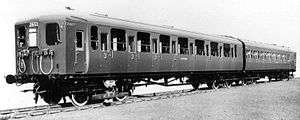British Rail Class 402
The Southern Railway (SR) gave the designation 2-HAL to the electric multiple units built during the late 1930s to work long-distance semi-fast services on the newly electrified lines from London Victoria to Maidstone and Gillingham (Kent). This type of unit survived long enough in British Rail ownership to be allocated TOPS Class 402.
| Southern Railway 2-HAL British Rail Class 402 | |
|---|---|
 Southern Railway publicity photograph 1938 | |
| In service | 1939–1971 |
| Manufacturer | Eastleigh Works, frames from Lancing |
| Replaced | Steam locomotives and carriages |
| Constructed | 1938–1939, 1948, 1955 |
| Number built | 100 |
| Number scrapped | All |
| Formation | DMBT-DTC |
| Capacity | 32 first class (later 24), 102 third class |
| Operator(s) | Southern Railway and British Railways |
| Specifications | |
| Train length | 129 ft 6 in (39.47 m) |
| Width | 9 ft 2 in (2.79 m) |
| Maximum speed | 75 mph (121 km/h) |
| Weight | 76 long tons (77 t; 85 short tons) |
| Traction motors | Two |
| Power output | 2 x 275 hp (205 kW) total = 550 hp (410 kW) |
| Electric system(s) | 750 V DC Third rail |
| Current collection method | Contact shoe |
| UIC classification | Bo′2′+2′2′ |
| Braking system(s) | Electro-pneumatic Air |
| Coupling system | Screw-link |
| Track gauge | 4 ft 8 1⁄2 in (1,435 mm) standard gauge |
Construction
A development of the earlier 2-BIL units, the 2-HAL units (2-car Half Lavatory stock) were so-called because only one car in each unit had a lavatory. They were built in three batches:
| Units | Built | Intended Use |
|---|---|---|
| 2601–2677 | 1938 | London Victoria to Maidstone and Gillingham |
| 2677–2692 | 1939 | London Waterloo to Aldershot and Reading |
| 2693–2699 | 1948 | Post-World War II additional units |
| 2700 | 1955 | Accident replacement unit |
The handful of post-war units were of completely different appearance, of all-steel construction, and looked very like the standard 4-SUB units being built at the same time, with flat ends, whereas the main 2-HAL units had the domed end appearance of the first 10 prototype "Queen Mary" 4-SUB units.
In the early 1960s the Eastern Division was fully changed over to EP-braked electric stock, and the 2-HAL units operating from Victoria to Maidstone/Gillingham etc. were removed to the Central and Western Divisions, being replaced by the large new build of 2-HAP units. The units then remained in service on these divisions until replaced at the end of their life by new 4-VEP units.
Formations
The original formations of these units are set out in the table below:
| Unit Numbers | DMBT | DTC |
|---|---|---|
| 2601–2646 | 10719 to 10764 | 12186 to 12231 |
| 2647–2699 | 10765 to 10817 | 12801 to 12853 |
| 2700 | 12664 (ex 4-SUB 4590) | 12855 (new build) |
2-PAN
In 1971 six units were converted for use conveying parcels and newspaper traffic. They were renumbered 061-066 and designated 2-PAN (2-car Parcels and Newspapers stock), reusing the PAN code originally allocated to 6-PAN (Pantry) stock. Their life was not extended by long; within two years all had been withdrawn.
Withdrawal
After withdrawal in 1971, various 2-HAL units in company with 2-BIL units were noted at Stratford in east London destined for scrapping by Kings of Norwich, or being hauled west for scrapping in the Newport area.[1]
References
- "Motive power miscellany". Railway World. Vol. 32 no. 378. Shepperton: Ian Allan. November 1971. p. 508.
- Marsden, Colin J. (1983). Southern Electric Multiple-Units 1898–1948. Shepperton, Surrey: Ian Allan Limited. pp. 59–61. ISBN 0-7110-1253-9.